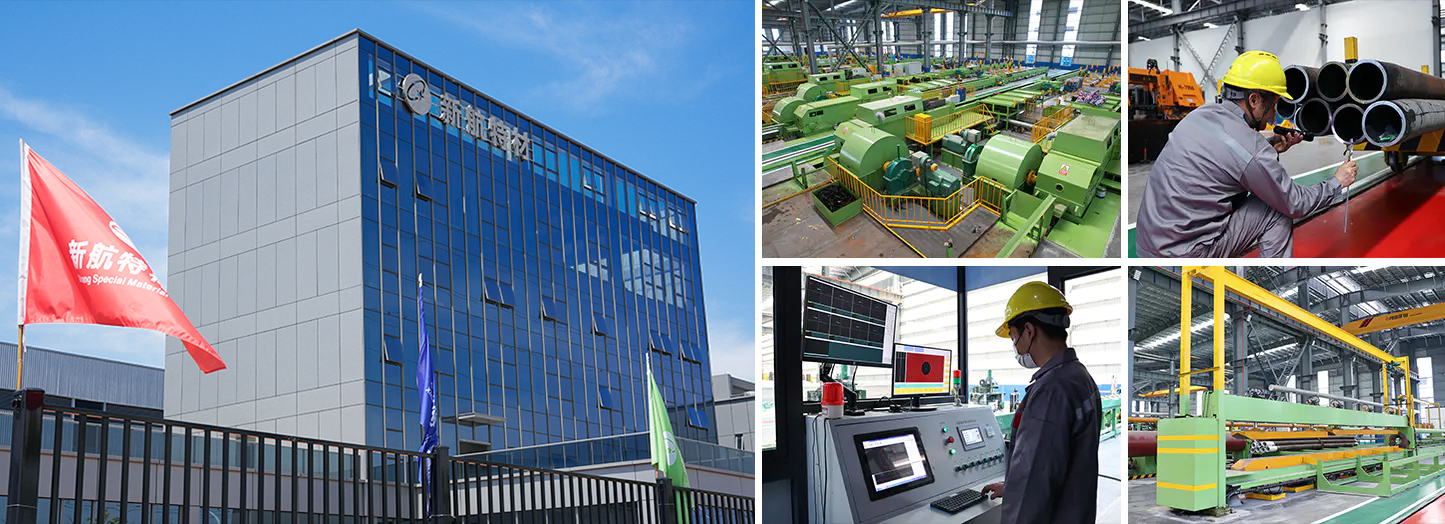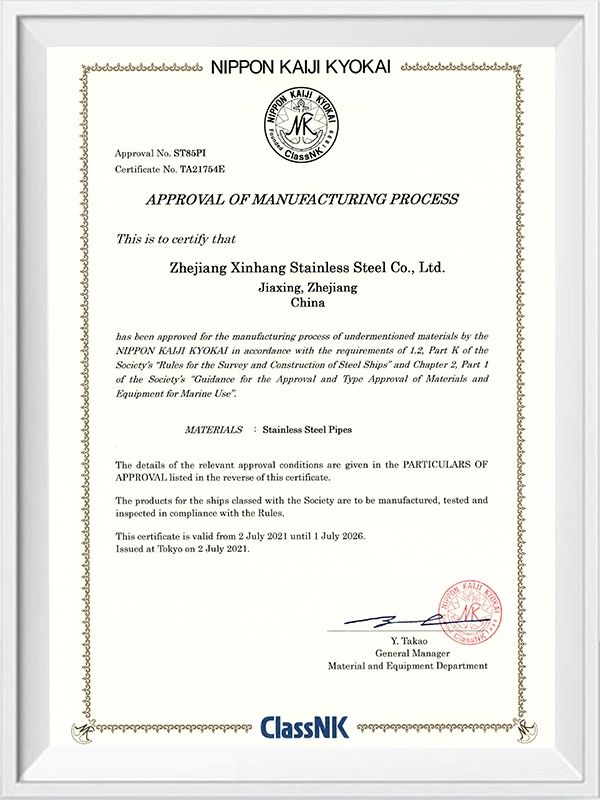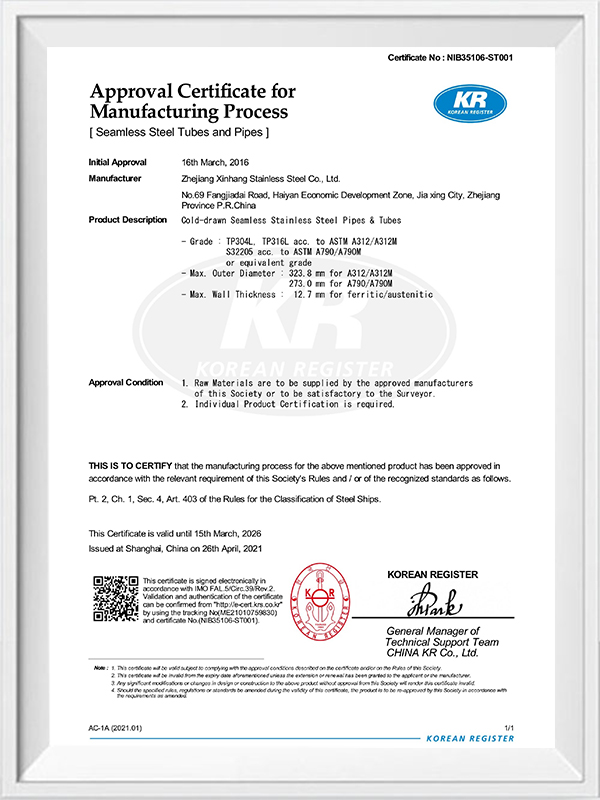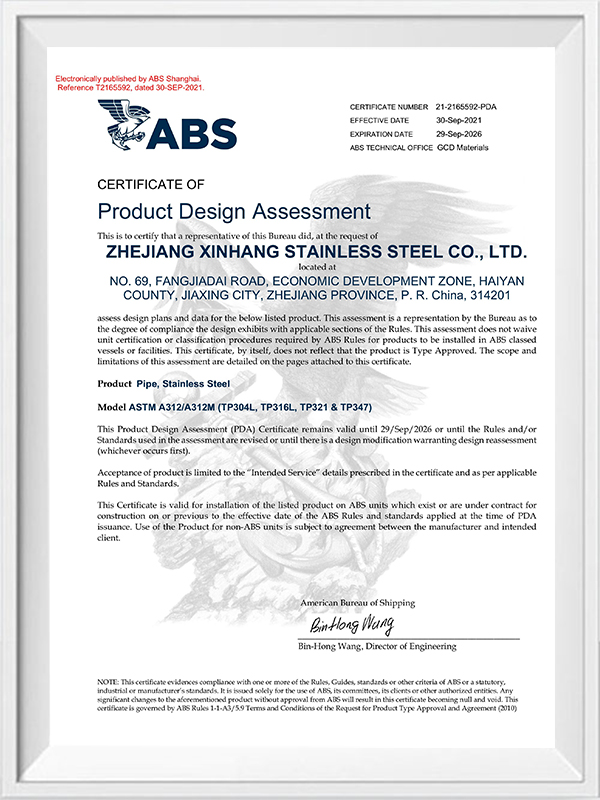

Xinhang Special Material Co., Ltd. Hangzhou Branch is China Stainless Steel Plate Flanges Manufacturers and Stainless Steel Plate Flanges Factory, founded in 2007 and moved to Longyou Economic Development Zone, Zhejiang Province, in 2022. It covers an area of 130,000 square meters, more than 30 production lines, 300 workers, 20 R&D people, 30 inspection people and an annual output of 50,000 tons.
It has passed ISO9001:2008 quality management system, PED 97/23/EC EU Pressure Equipment Directive certification, China Special Equipment Manufacturing License (Pressure Tube) TS certification, ASME certification, provincial enterprise standardization management system, ISO14000:2004 environment management system, cleaner production (green enterprise), and a series of certifications, as well as China Classification Society (CCS), American Bureau of Shipping (ABS), British Register of Shipping (LR), Deutsche Veritas (GL), Bureau Veritas Society (BV), Det Norske Veritas (DNV), and Korean Register of Shipping (KR) factory certification.
The main products include stainless steel pipes, pipe fittings, flanges, valves, etc., which are widely used in petroleum, chemical industry, nuclear industry, smelting, shipbuilding, pharmaceuticals, food, water conservancy, electric power, new energy, mechanical equipment, and other fields. The company adheres to the corporate tenet of "quality for survival, reputation for development" and wholeheartedly serves every customer to create a win-win situation.




Introduction to Alloy Steel Alloy steel is a type of steel that is made by combining carbon steel wi...
View MoreMass Density of Mild Steel: Basics and Practical Importance The mass density of mild steel is a fund...
View MoreUnderstanding Stress Proof Steel Stress proof steel is a type of alloyed steel engineered to resist ...
View MoreIntroduction to Low Alloy Steel Material Low alloy steel material is a type of steel that contains a...
View MoreOverview — what "weight per cubic inch" means for stainless steel "Weight per cubic inch" is simply ...
View MoreWhat are the common applications of stainless steel plate flanges?
Stainless steel plate flanges are used in a variety of industrial and commercial applications due to their durability, corrosion resistance, and versatility. Some common applications include:
Piping Systems: Stainless steel plate flanges are frequently used in piping systems for connecting pipes, valves, pumps, and other equipment. They provide a secure and leak-proof connection while withstanding high pressures and temperatures.
Chemical Processing: In industries such as chemical processing, where corrosive chemicals are involved, stainless steel plate flanges are preferred for their resistance to corrosion and chemical attack.
Oil and Gas Industry: Stainless steel plate flanges find extensive use in the oil and gas industry for connecting pipelines, offshore platforms, refineries, and petrochemical plants. They can withstand harsh environmental conditions and resist corrosion caused by oil, gas, and seawater.
Water Treatment: Stainless steel plate flanges are used in water treatment plants and facilities for connecting pipes and fittings in water distribution systems, wastewater treatment plants, and desalination plants. They are resistant to corrosion from water and chemicals used in treatment processes.
Food and Beverage Industry: Due to their hygienic properties and resistance to corrosion, stainless steel plate flanges are commonly used in the food and beverage industry for processing, bottling, and packaging applications.
Power Generation: In power generation facilities such as power plants and nuclear reactors, stainless steel plate flanges are used in piping systems for steam, water, and other fluids. They can withstand high temperatures and pressures encountered in power generation processes.
HVAC Systems: Stainless steel plate flanges are employed in heating, ventilation, and air conditioning (HVAC) systems for connecting ductwork, air handlers, and other components. They offer durability and resistance to corrosion in HVAC environments.
Construction and Infrastructure: In construction projects, stainless steel plate flanges are used in structural applications such as bridges, buildings, and tunnels for connecting steel beams, columns, and other structural elements.
How do you select the right size and thickness of a stainless steel plate flange for a specific application?
Selecting the right size and thickness of a Stainless steel plate flange for a specific application involves considering several factors:
Pressure Rating: Determine the maximum pressure the flange will be subjected to in the application. This will dictate the thickness of the flange material needed to withstand the pressure without deformation or failure.
Pipe Size and Schedule: Match the flange size to the size and schedule of the pipe it will be attached to. Flanges come in various sizes and standards (e.g., ANSI B16.5), so ensure compatibility with the pipe dimensions.
Material Compatibility: Choose stainless steel grade suitable for the application. Factors like temperature, fluid composition, and corrosiveness should be considered. Common grades include 304, 316, and 316L stainless steel.
Temperature: Consider the operating temperature of the system. Elevated temperatures can affect the mechanical properties of stainless steel, so select a thickness that can handle the temperature without significant deformation or loss of strength.
Gasket Type and Material: The type and material of the gasket used between the flange faces can affect the required compression and sealing properties. Ensure compatibility between the gasket and the flange material and design.
Flange Standards and Regulations: Adhere to relevant industry standards and regulations (e.g., ASME B16.5, ASTM standards) to ensure the flange meets required specifications for the application.
Environmental Conditions: Consider environmental factors such as exposure to corrosive substances, weather, and potential mechanical stresses that could affect the performance of the flange.
Alignment and Installation: Ensure proper alignment and installation of the flange to prevent leaks and maintain structural integrity. Proper bolt torque and tightening sequence are critical for sealing and preventing flange leakage.
We'll never share your email address and you
can opt out at any time, we promise.